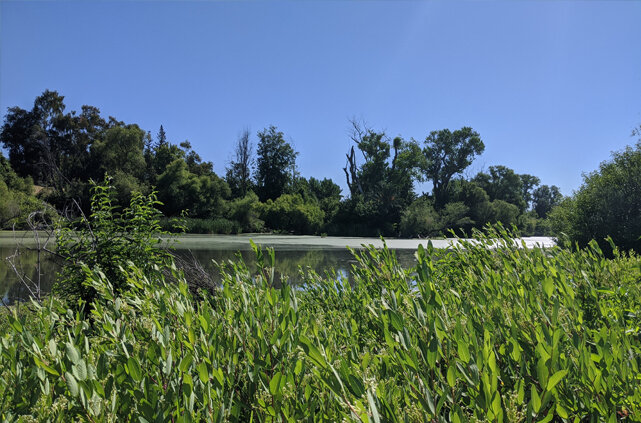Education & Research
Bushy Lake Eco-Cultural Restoration Conceptual Restoration Plan
June 2024
Information on Western Pond Turtles (Actinemys marmorata) Proposed for Listing as Threated by USFS
October 2023
Bushy Lake Quarterly Report
July 2022
Bushy Lake Summary Report
2021
California Wildlife Conservation Board Grant Agreement for Bushy Lake Conceptual Restoration Plan WC-1943CA | Data Contributing to Critical Elements for Western Pond Turtle Habitat
Western and Traditional Ecological Knowledge in Ecocultural Restoration
Zedler, J.B. and Stevens, M.L., 2018. Western and traditional ecological knowledge in ecocultural restoration. San Francisco Estuary and Watershed Science, 16(3).
Water Education
Focuses on Bushy Lake’s role in the regional waterscape including riverine interactions (both groundwater and surface water flows), and urban hydrology (storm water runoff from adjacent neighborhoods). Water quality aspects of these interactions will also be addressed, promoting scientific understanding and stewardship.
Developed by Julian Fulton, PhD
Sacred Pollinators
The experimental design and data collection and analysis were originally developed with the objective of developing a fire resilient native plant palette. In 2021, we began planting pollinator species, including plants that are important for sacred pollinators such as bees, monarchs and other butterflies.
Bees Field Guide - Developed by Rio Lininger
Bushy Lake Restoration, Monitoring, and Adaptive Management on the American River, Sacramento, California
By Professor Michelle Stevens, PhD
Wildlife at Bushy Lake
Bushy Lake is a diverse habitat that provides a vital refuge for many species of birds and aquatic animals. It is a popular birding hotspot on the American River Parkway and is well known for its avian diversity. It is also a great place to catch a glimpse of Western Pond Turtles and North American River Otters.
The Bushy Lake Ecosystem
Developed by Jamie Kneitel, PhD
Wildlife at Bushy Lake
Developed by Kayla Henry, B.S.
Bushy Lake Geology and Soils
Soils of Bushy Lake are formed by a combination of human compaction and alluvial deposition.
Developed by Michelle Stevens, PhD
Ethnobotany of the Bushy Lake/Cal Expo Area
Culturally significant plants and animals in the area will be identified, and their cultural uses, traditional knowledge systems, and traditional resource management described.
Developed by Sage LaPena
Eco-cultural Restoration of Riparian Wetlands in California: Case Study of White Root (Carex barbarae Dewey; Cyperaceae)
Stevens, M.L., 2020. Eco-cultural restoration of riparian wetlands in California: case study of white root (Carex barbarae Dewey; Cyperaceae). Wetlands, 40(6), pp.2461-2475
Western Pond Turtles
Bushy Lake houses one of California’s only native freshwater turtle species, the Western Pond Turtle. Unfortunately, Bushy Lake is also filled with invasive turtle species such as the Red-Eared Slider and Yellow Bellied Slider.
Developed by Michelle Stevens, PhD and Alexandra von Ehrenkrook
Information on Western Pond Turtles (Actinemys marmorata) Proposed for Listing as Threated by USFS - October 12, 2023
Bushy Lake Turtle Research - Need for protection during nesting season
Avian Diversity
Historically, Bushy Lake has provided vital habitat for a variety of birds and is a popular birding location (Audubon Society).
By Daniel Williams
Salmon and Steelhead in the American River
The American River provides habitat for native and non-native fish. Native fish are specially adapted to conditions in Northern California’s inland rivers. Common native fish in the American River include Sacramento sucker, Sacramento pikeminnow, hardhead, Sacramento tule perch, Central California roach, Santa Ana speckled dace, prickly sculpin, hitch, Sacramento splittail, mosquito fish, Pacific lamprey, rainbow trout, green and white sturgeon, steelhead, and several varieties of salmon.
Developed by Tim Horner, PhD
Butterflies
While these are some of the most common butterflies found in habitats like Bushy Lake, there are 50+ more species you could see that are not listed here.
Developed by Rio Lininger
Beavers
Beavers were first discovered at Bushy Lake in 2019. They are a keystone species and an ecosystem engineer. Evidence of beavers at Bushy Lake includes the felling of trees, two lodges, canals or “beaveways,” an upcoming beaver dam, and visual encounters. A single beaver has been observed at a time, however based on the large-sized lodges with freshly cut vegetation, it is hypothesized that a colony resides at Bushy Lake.
Developed by Alexandra von Ehrenkrook














